|
Here’s my question, if a segment
of a community’s history is demolished because of a well-intentioned government
program called, ironically enough, Urban Renewal – does said history still
exist?
Cape May’s Afro-American history nearly faded into the haze of
demolition dust, but when a group of mostly white local artists got together in
1994 and went looking for a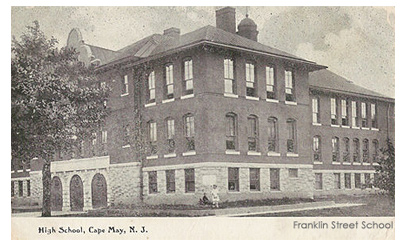 good arts center, they took a second look at the
Franklin Street School. The school was built as a segregated school for the
city’s black elementary students. It continued as such from 1928-1948, the year
the State of New Jersey outlawed segregation. good arts center, they took a second look at the
Franklin Street School. The school was built as a segregated school for the
city’s black elementary students. It continued as such from 1928-1948, the year
the State of New Jersey outlawed segregation.
The summer of ’91 also brought some tension between Afro-American
youths and Cape May’s summer police. When the artists approached the black
community about restoring the school and turning it into a community arts
center, the two groups merged and began working in tandem to renovate the school
and gather more information about the graduates who went there. By learning
about the graduates, historians began to learn more about the way things were in
the Afro-American community before the impact of Urban Renewal began in the late
1960s and early 1970s.
Twelve years later the
Center for Community Arts (CCA) is in the
midst of an extensive renovation of the Franklin Street School and has developed
an African American Walking Tour of Cape May, retracing the steps of those who
once worked, lived and thrived in Cape May. The tour begins in front of CCA
headquarters at 712 Lafayette Street, moves over to the Franklin Street School
on Franklin Street and then
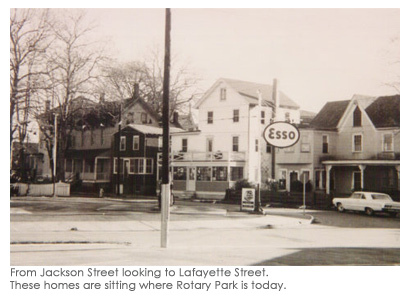 proceeds west to the Irish Shop at Lafayette and
Jackson streets. proceeds west to the Irish Shop at Lafayette and
Jackson streets.
In the 1920s Afro-Americans comprised about 30 percent of Cape
May’s population. Nearly 60 of the businesses in the district were owned by
African Americans.
So picture this – if you’re standing in the parking lot of the
Irish Shop (which used to be the English Shop back in the day) on the corner of
Lafayette and Jackson streets looking across the street to Rotary Park, you are
in the heart of the Afro-American business district. The location of the Irish
Shop was the Douglas Hotel – locals remember the segregated hotel by its
nickname, “The Bedbug Inn.” Not exactly your upscale accommodations spot, I’m
guessing.
Around the corner on Jackson Street at Perry Street, where
Mariah’s, Guardian Angel and the Bamboo Shack are located, was another
blacks-only hotel called the New Cape May Hotel, owned by a man by the name of
Richardson.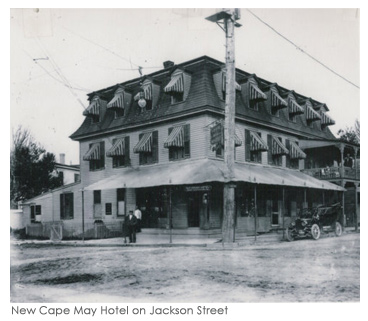
Next door, where Cape Savings Bank stands today, was the site of the
Opera House, owned by prominent Afro-American businessman Edward Dale, described
by those who remember him as being an elegant man who owned several businesses
in town, including the Dale Hotel at the corner of Lafayette and Jefferson
streets (the brick building is all that is left of the hotel.)
People came there to see movies the Opera House, to attend boxing
matches and to see concerts which showcased local as well as nationally famous
artists. Because blacks were not permitted inside the white USO, located on the
second floor of the four-story Focer-Mecray Building on Washington Street – now
the site of the Victorian Towers – another Urban Renewal inspired project -
during WWII, the Opera House served as USO for black servicemen. Paul Robeson
entertained to a full house there in 1943 when he appeared by special invitation
to dedicate the building as the black USO.
Colliers Liquor Store was a speakeasy run by the current owner’s uncle.
Then it became Charlie’s B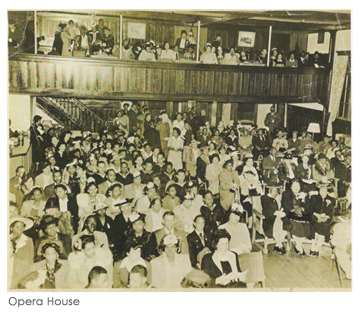 ar and then Collier’s Liquor Store. ar and then Collier’s Liquor Store.
There was no Rotary Park. Lafayette and Mansion and Chestnut
streets were filled with boarding houses, private residences and black-owned
businesses. Many blacks came to Cape May at the turn of the century to help
build the railroad. Empty lots in town at that time were cheap and they bought
them with the money earned by working on the railroad.
Bill Allison and Edward Dale, were among those men who worked hard,
saved their money and invested it wisely. Allison was one of the wealthiest
businessmen in Cape May and owned quite a number of properties. He ran a pool
hall located where the Rotary Park gazebo is now. Often, according to the
recollection of folks who grew up during that era, Allison welcomed local
teenagers to play pool to keep them off the streets and out of mischief. His
daughter Elizabeth still lives in West Cape May and his other daughter Kitty
owned a beauty parlor on Jackson Street.
Allison also owned a guesthouse for resort workers and tradespeople.
Someone walking along Lafayette or Mansion Street in the heydays from the turn
of the century to the late fifties would have found strong community of
black-owned or managed businesses. Along with Allison’s Pool Hall and boarding
house, was an auto mechanic, a carpenter, a plasterer, a blacksmith and a
wallpaper hanger. There was an employment agency on Mansion Street for African
Americans looking for summer employment. There were also four drugstores in
town, one of them at the corner of Washington and Decatur streets – all with
soda fountains - and several small grocery stores. These establishments catered
to both a white and black clientele.
Broad Street was another neighborhood of black-owned businesses,
according the late Jack Vasser who died in 2003 and was the mayor of West Cape
May for more than 30 years .He was the third generation of a family that owned
several pieces of property and a trash pick up business in both communities.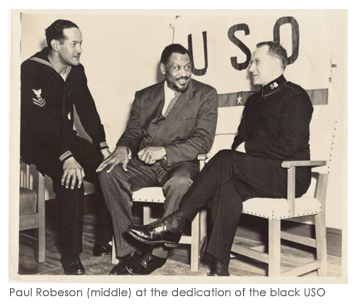
Stephen Smith, one of the richest black men east of the Mississippi
in pre-Civil War Cape May, summered on 645 Lafayette Street. A Philadelphia
industrialist, he founded the African Methodist Episcopal (AME) Church also
located on Franklin Street.
Smith’s house was targeted, along
with everything else standing between Franklin and Mansion streets, for
demolition, when Amelia Hampton, who owns the house and still summers there,
appealed to then President Lyndon B. Johnson to save the historic home. LBJ
responded immediately, via Western Union telegram, forbidding its destruction.
By the 1960s much of the area that
once thrived had become, like Cape May in general, dilapidated and vulnerable to
the wrecking crane. In place of bustling businesses patronized by both white and
black patrons, Rotary Park and Lyle Lane (which basically serves as a parking
lot for the Washington Street Mall) were built instead. In addition to the
Stephen Smith House, only three structures are left from those Victorian,
two-story clapboard buildings – the building housing Mariah, et al; Island
Grill, formerly the Mansion House and prior to that still owned by descendents
of an African American family; and Colliers Liquor Store.
Even the churches have morphed in
this day of condo-mania. The Franklin Street Methodist Church was built in 1879
as a Baptist church and is a key building contributing to Cape May’s status as a
National Historic Landmark. This church had a tower that enhances its classic
Victorian Gothic Revival architecture, but it was destroyed by lightening.
Around town it is simply known as the “Yellow Church.” It was sold and converted
to condominiums two years ago as part of a Designer House project.
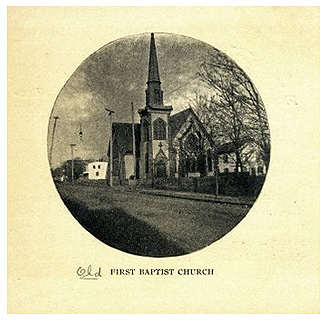 Although it started out as a
Baptist Church, the Baptist congregation moved to its present location on Gurney
and Columbia in 1913 because the white congregation wanted to leave the
increasingly black neighborhood. A black Methodist congregation moved in and was
active until the sale of the building. Although it started out as a
Baptist Church, the Baptist congregation moved to its present location on Gurney
and Columbia in 1913 because the white congregation wanted to leave the
increasingly black neighborhood. A black Methodist congregation moved in and was
active until the sale of the building.
Work continues on the Franklin
Street School in preparation for a grand reopening slated for next year, and
while many work on the façade the other building, others diligently are working
to recreate the oral and physical history of this once vibrant African American
business district. According to Community History Committee chair and CCA board
member Harry Bellengy, the hope is that from a segregated past, an integrated
future will result.
The African American Heritage
Walking Tour of Cape May, sponsored by CC, will resume in April, weather
permitting and will be offered on Thursdays and Saturdays at 11 a.m. leaving
from CCA at 712 Lafayette Street.
Ed. Note: Our thanks to the CCA for allowing us
the use of their photos and to Mr. Bellengy, and CCA history committee
member Hope Gaines for their input. Much of the information in the article came
from the African American Heritage Walking Tour script. |

